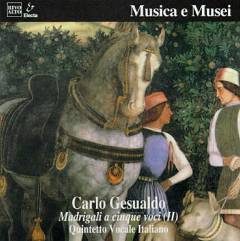Gesualdo da Venosa - Madrigali a 5 Voci Libro II (2012)
Gesualdo da Venosa - Madrigali a 5 Voci Libro II (2012)

[1] Caro amoroso neo [2] Hai rotto, e sciolto [3] Se per lieve ferita [4] In piu leggiadro velo [5] Se cosi dolce e il duolo [6] Se taccio il duol s'avanza [7] O come e gran martire [8] Sento che nel partire [9] Non e questa la mano [10] Candida man [11] Dalle odorate spoglie [12] Non mai non cangiero [13] All'apparir di quelle [14] Non mi toglia il ben mio Quintetto Vocale Italiano: Karla Schlean soprano Clara Foti mezzo-soprano Elena Mazzoni contralto Gastone Sarti baritone Dmitri Nabokov bass
Although he produced some valuable sacred music, and even some instrumental music, Gesualdo's main compositional outlet was the five-voice madrigal. A shred of a collection for six voices survives, but we don't really know what wonders it contained. His first two collections of madrigals appeared together in 1594 and were somewhat popular in their day. Compared to the infamous works of his fifth and sixth collections, the music in them is extremely tame, but all the seeds of the later style are there.
A number of the madrigals in Book 2, like those in Book 1, are taken to show that Gesualdo wanted to place himself into direct, competitive comparison with his contemporaries and predecessors. As an aristocrat, Gesualdo had to forge his musical reputation in face of the automatic judgment of "dilettante" or "dabbler" made against those of his class who tried to distinguish themselves in art. Not that the Prince of Venice, as he was, had any doubts about his genius, but he must have seen that his best hope for avoiding such demeaning charges was to confront the issue directly. So, a number of the pieces, O come e gran martire, Dalle odorate, and Non mirar, non mirare, to name a few, were settings of texts that had already been used by already prominent madrigalists. Two of those mentioned had been famously set by Luzzasco Luzzaschi, the one composer Gesualdo, in his absolute self-confidence, acknowledged both as an influence and rival to be feared. Dalle odorate in fact directly borrows elements from Luzzaschi's setting in order, certainly, to make the comparison more direct, but in a number of details he improves the work and shows himself already the more cunning, adventurous composer.
In Book 2 he demonstrates his mastery of accepted compositional models, his craftsman's patient care, and his affinity with developments of the madrigal in his time. At this stage he's mainly concerned with extending current contrapuntal techniques. The openings of madrigals for example, tend to be intensely cramped; instead of gradual reasonable introductions of the motifs and variations, he plunges us immediately, in works like Candida man into a volatile, fluid world where material is introduced and varied almost simultaneously. Elsewhere, he uses sophisticated contrapuntal techniques like double counterpoint, in which two imitative strains are developed simultaneously across the voices.
What's already most clear in Book 2, however, is Gesualdo's especially exquisitely sensitive appreciation of the texts he's using. With a glance at the text, and a comparison with settings made by others, we can hear that Gesualdo grasped poetic nuance in a way few have. Especially impressive is the way he can draw out several different emotional interpretations of the same phrase. In pursuit of the goal, he's already smashing the texts to bits, overlapping lines and phrases, and using severe, sudden contrasts of tempo to make instantaneous climate changes. His later harmonic and rhythmic adventurings only increased his power to express his inborn talents. ---Donato Mancini, Rovi
download (mp3 @320 kbs):
uploaded yandex 4shared mega mediafire solidfiles zalivalka cloudmailru oboom
Last Updated (Tuesday, 03 March 2015 16:32)
